Abstract
This paper
describes the development of the InSite® Test Kit. This
kit is comprised of two main components: acid
phosphatase (AP) test strips and
prostate specific antigen (PSA) test strips, which work
together to provide evidence of semen on garments and other
items.
The included AP strips were found to detect semen
down to a 1/2000 dilution, whereas comparative testing with
two other acid phosphatase (AP)
tests and a zinc test showed that their limit of detection was 1/150-1/300.
The
PSA strips detected semen to a
1/500,000 dilution,
which was
approximately the same as semenogelin test strips used in
comparative testing.
Semen which was discharged onto undergarments was detectable by the AP tests up to 17 h, by the
zinc test up to 17 h, and by the PSA and semenogelin tests up
to 36 h after intercourse. The AP test gave a
more dramatic color change with small amounts of semen and therefore
was chosen for inclusion in the kit over the zinc test.
The zinc test, on the other hand, was more specific and
would be superior when testing directly with a vaginal swab. In contrast with
spermatozoa, which can be found in the vagina more than
seven days after intercourse, the marker proteins PSA
and semenogelin became undetectable after 36 hours. We attribute this difference to
the acidic pH of the vagina, among other factors.
Introduction
Conservative
statistics indicate that about 14% of women and 22% of men
have had affairs sometime in their marriage
[Ref. 1].
According to a recent study by the Centers for Disease
Control, about 4% of both married men and women had more
than one sexual partner in the previous twelve months
[Ref.
2]. This figure rises to 15% in the case of
unmarried couples cohabiting. These data indicate that infidelity is a
significant
problem in the United States, and there exists a need to
objectively test spouses for sexual activity. For
women, one such test is for the presence of semen.
When a man has sexual
intercourse with a woman, semen
is deposited into the woman's
vagina. Immediately after
intercourse, most of the semen
flows back out, but a some is retained in the vagina
and slowly is discharged over a
period of several days
[Ref. 3].
Semen has over 900 identified
proteins
[Ref. 4]
among which are semenogelin I
and II (gel-forming proteins
produced by the seminal
vesicles), prostate-specific
antigen (a protease which breaks
down semenogelin), and acid
phosphatase (which breaks down
spermatozoa cell membranes)
[Ref. 5].
These proteins can be identified
by immunochromatographic assay,
which forms the principle of the
PSA test in the InSite kit.
Acid phosphatase can be detected by
the classic test first described
by Babson
[Ref. 6], which forms
the principle of the AP test in
the InSite kit. This
test relies on the
catalytic hydrolysis of
1-naphthyl phosphate to form
1-naphthol, which in turn reacts
with an aryl diazonium salt,
forming an intensely colored azo
dyestuff. In addition to proteins, semen
also has unusually high
concentrations of zinc (100-200
mg/L v. 1 mg/L in plasma)
[Ref. 7].
Zinc acts to stabilize DNA
inside spermatozoa and also may
catalyze the gel-forming
reaction between semenogelin I
and II. Semen may be
detected by the modified zinc
test of Hooft and van de Voorde
[Ref. 8],
which forms the principle of the
zinc test developed during this
research.
The semen flowing back out of a
woman's vagina ("backflow") is
deposited on her underwear or
absorbent pad. These items
conveniently can be tested with
the InSite kit. The kit
also can be used to test stains
on other fabrics and surfaces.
There was some question as to how
long after intercourse marker
proteins like PSA and
semenogelin could be detected,
because of the acidic pH in the
vagina, among other factors. The predominant
microorganism in the vagina is
lactobacillus acidophilus, which
produces lactic acid and
hydrogen peroxide, creating a
toxic environment for other
bacteria and denaturing the
three-dimensional structure of
proteins, which structure is critical for
their immunochromatographic
detection. The detection
limits for these proteins were
measured experimentally as
described below.
Results and Discussion
Acid
phosphatase test strips were prepared according to a
modification of the procedure of Babson
[Ref. 6]. Zinc test
strips were prepared according to the method of Hooft and
van de Voorde, using various filter papers as
substrate. PSA, semenogelin and two other AP tests were obtained
commercially as described below. In order to measure
the relative sensitivity of these different tests, and their
ability to detect semen on undergarments, comparative
studies were performed with semen dilutions and with
analysis of garments after intercourse.
Semen dilutions
The
sensitivity of the zinc strips was tested by analyzing a
series of dilute semen samples, and acid phosphatase tests
were carried out simultaneously for comparison. Semen was
diluted with deionized water to levels of 1/10, 1/50, 1/100,
1/150, 1/200, 1/300, 1/500, 1/1,000 and 1/2,000 and tested with zinc strips and three acid
phosphatase tests (prototype InSite®, CheckMate® and
Phosphatesmo KM brands).
The zinc strips
proved to be sensitive to a 1/150 dilution, the prototype
InSite test had a detection limit of 1/100, the CheckMate® AP test
was judged to have a detection limit of 1/150 and the
Phosphatesmo KM test a detection limit of
1/300. The AP tests were read after 15 seconds, but at
high dilutions continued to slowly turn purple. The
results are shown in Fig. 1. The zinc and InSite AP
test strips in this experiment were prepared using Whatman
Grade 1 filter paper. The prototype InSite AP test (D)
in this experiment turned out to
be too weak, and the concentration of reagents in this strip later was
increased.
The limit of detection of semen
at a 1/150 dilution by the zinc spot test is generally consistent with the report
of Hooft and van de Voorde, who reported a detection limit
of 1/128 [Ref. 8].
The Phosphatesmo KM strips were
clearly superior as a spot test for detecting semen in this
experiment because
of the dramatic color change, the small amount of enzyme needed for a reaction and the
strip's overall design. It was initially thought that, because of acidic
conditions in the vagina, it might turn out that zinc would be the
best test beyond a certain time frame, e.g. 12 hours.
This turned out not to be true, as shown below. The
Phosphatesmo KM strips were also somewhat expensive, at $5 each.
|
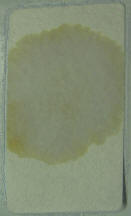
|

|
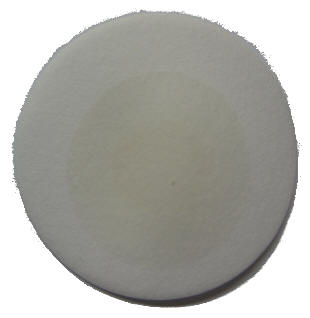
|

|
|
Control
|
Control
|
Control
|
Control
|
|
A
|
B
|
C
|
D
|
|
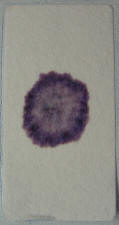
|

|
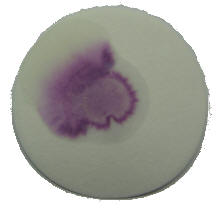
|

|
|
1/10
|
1/10
|
1/10
|
1/10
|
|
A
|
B
|
C
|
D
|
|
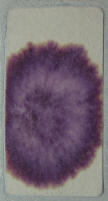
|

|
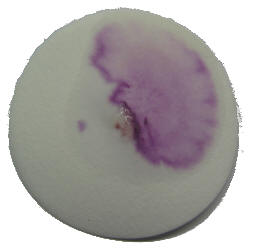
|

|
|
1/100
|
1/100
|
1/100
|
1/100
|
|
A
|
B
|
C
|
D
|
|
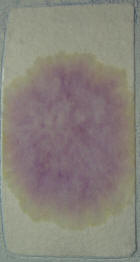
|
|
1/500
|
|
A
|
|
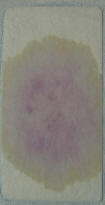
|
|
1/1,000
|
|
A
|
|
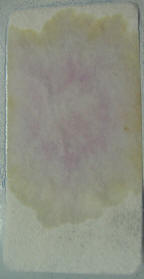
|

|
|
1/2,000
|
1/2,000
|
|
A
|
B
|
|

|
|
0-1/2,000 Series
|
|
B
|